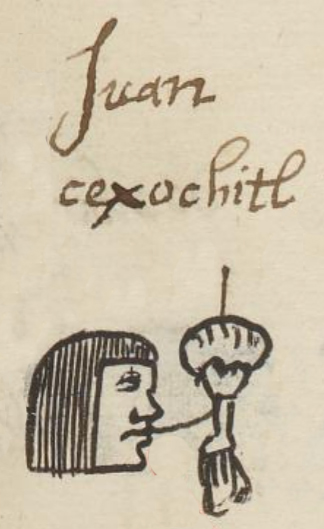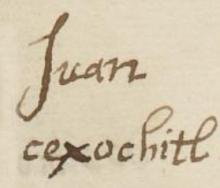Ce Xochitl (MH501r)
This black-line drawing of the simplex glyph plus notation for the personal name Ce Xochitl (here, attested as a man’s name) shows one (ce) flower (xochitl). This is a date that includes a day sign. The flower is upright with a stem, a base, and a blossom on top. The flower has hash marks at the top suggesting multiple petals or another type of texturing. Coming up from the very top of the flower is a short line that is a notation for the number one. The variation in the color of the ink suggests that it was added after the fact.
Stephanie Wood
This day sign comes from the tonalpohualli, the 260-day divinatory calendar. Calendrics figure importantly in Nahuas' religious views of the cosmos. Dates in the Matrícula de Huexotzinco diverge somewhat from calendrical representations from earlier codices. The numbers sometimes drop away, and sometimes they are shown in new formats for notations. See below. Cecuauh, "One Eagle," has no notation, for example. Cetoch, "One Rabbit," has a dot for the one. Matlaccuauh has one more than the expected ten dots.
Stephanie Wood
Juan
cexochitl
Juan Ce Xochitl
Stephanie Wood
1560
Jeff Haskett-Wood
flores, flowers, dates, fechas, calendario, nombres de días, nombres de hombres

ce, one, https://nahuatl.wired-humanities.org/content/ce
xochi(tl), flower, https://nahuatl.wired-humanities.org/content/xochitl
Uno Flor, o 1-Flor
Stephanie Wood
Matrícula de Huexotzinco, folio 501r, World Digital Library, https://www.loc.gov/resource/gdcwdl.wdl_15282/?sp=81&st=image
This manuscript is hosted by the Library of Congress and the World Digital Library; used here with the Creative Commons, “Attribution-NonCommercial-ShareAlike 3.0 License” (CC-BY-NC-SAq 3.0).







